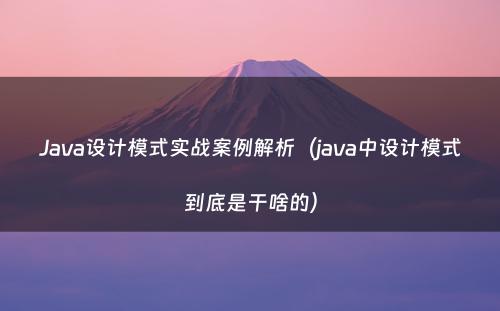网站首页 > java教程 正文
Java设计模式实战案例解析
在软件开发中,设计模式是一种经过验证的方法,用于解决常见的设计问题。它们不仅能够提高代码的复用性、灵活性和可维护性,还能促进团队成员之间的沟通和协作。本文将通过几个具体的实战案例,带你深入了解几种常用的Java设计模式。
目录
- 单例模式:确保一个类只有一个实例,并提供一个全局访问点。
- 工厂模式:定义创建对象的接口,但让子类决定实例化哪一个类。
- 观察者模式:定义对象间的一对多依赖关系,当一个对象的状态发生改变时,所有依赖于它的对象都会得到通知并自动更新。
- 装饰器模式:动态地给一个对象添加一些额外的职责。
- 策略模式:定义一系列算法,把每一个算法封装起来,并且使它们可以相互替换。
- 总结与反思
1. 单例模式
单例模式的核心思想是确保一个类只有一个实例,并提供一个全局访问点。这在需要频繁创建和销毁的对象时特别有用,比如数据库连接池。

代码实现
public class Singleton {
// 私有的静态实例变量
private static Singleton instance;
// 私有的构造方法
private Singleton() {}
// 公共的静态方法获取实例
public static Singleton getInstance() {
if (instance == null) {
synchronized (Singleton.class) {
if (instance == null) {
instance = new Singleton();
}
}
}
return instance;
}
public void showMessage() {
System.out.println("Hello, I'm a Singleton!");
}
}
使用场景
假设我们需要一个全局唯一的配置管理器:
public class ConfigManager {
public static void main(String[] args) {
Singleton configManager = Singleton.getInstance();
configManager.showMessage();
}
}
小贴士
单例模式的实现需要注意线程安全问题。上面的代码使用了双重检查锁定(Double-Checked Locking)来确保线程安全。
2. 工厂模式
工厂模式用于定义创建对象的接口,但让子类决定实例化哪一个类。工厂方法让一个类的实例化延迟到其子类。
代码实现
// 创建一个接口
interface Shape {
void draw();
}
// 创建实现类
class Circle implements Shape {
@Override
public void draw() {
System.out.println("Drawing Circle");
}
}
class Square implements Shape {
@Override
public void draw() {
System.out.println("Drawing Square");
}
}
// 创建工厂类
class ShapeFactory {
public Shape getShape(String shapeType) {
if (shapeType == null) {
return null;
}
if (shapeType.equalsIgnoreCase("CIRCLE")) {
return new Circle();
} else if (shapeType.equalsIgnoreCase("SQUARE")) {
return new Square();
}
return null;
}
}
使用场景
假设我们需要根据不同的图形类型绘制不同的形状:
public class FactoryPatternDemo {
public static void main(String[] args) {
ShapeFactory shapeFactory = new ShapeFactory();
// 获取 Circle 的对象,并调用它的 draw 方法
Shape shape1 = shapeFactory.getShape("CIRCLE");
// 调用 Circle 的 draw 方法
shape1.draw();
// 获取 Square 的对象,并调用它的 draw 方法
Shape shape2 = shapeFactory.getShape("SQUARE");
// 调用 Square 的 draw 方法
shape2.draw();
}
}
小贴士
工厂模式使得系统更加灵活,易于扩展新的产品类型,而无需修改现有的代码。
3. 观察者模式
观察者模式定义了一种一对多的依赖关系,当一个对象的状态发生改变时,所有依赖于它的对象都会得到通知并自动更新。
代码实现
import java.util.ArrayList;
import java.util.List;
// 创建 Subject 类
abstract class Subject {
protected List observers = new ArrayList<>();
public void attach(Observer observer) {
observers.add(observer);
}
public void detach(Observer observer) {
observers.remove(observer);
}
public abstract void notifyObservers();
}
// 创建 Observer 类
interface Observer {
void update();
}
// 创建 ConcreteSubject 类
class ConcreteSubject extends Subject {
private String state;
public String getState() {
return state;
}
public void setState(String state) {
this.state = state;
notifyObservers();
}
@Override
public void notifyObservers() {
for (Observer observer : observers) {
observer.update();
}
}
}
// 创建 ConcreteObserver 类
class ConcreteObserver implements Observer {
private String name;
public ConcreteObserver(String name) {
this.name = name;
}
@Override
public void update() {
System.out.println(name + " received update: State changed to " + ((ConcreteSubject) subject).getState());
}
}
使用场景
假设我们有一个天气预报系统,需要在状态变化时通知多个客户端:
public class ObserverPatternDemo {
public static void main(String[] args) {
ConcreteSubject weatherData = new ConcreteSubject();
ConcreteObserver observer1 = new ConcreteObserver("Observer 1");
ConcreteObserver observer2 = new ConcreteObserver("Observer 2");
weatherData.attach(observer1);
weatherData.attach(observer2);
weatherData.setState("Sunny");
weatherData.setState("Rainy");
}
}
小贴士
观察者模式非常适合处理事件驱动的应用程序,如GUI应用程序。
4. 装饰器模式
装饰器模式允许动态地给一个对象添加一些额外的职责。它比生成子类更灵活。
代码实现
// 创建 Component 接口
interface Coffee {
double cost();
}
// 创建 ConcreteComponent 类
class SimpleCoffee implements Coffee {
@Override
public double cost() {
return 10;
}
}
// 创建 Decorator 类
abstract class CoffeeDecorator implements Coffee {
protected Coffee decoratedCoffee;
public CoffeeDecorator(Coffee coffee) {
this.decoratedCoffee = coffee;
}
@Override
public double cost() {
return decoratedCoffee.cost();
}
}
// 创建 ConcreteDecorator 类
class MilkCoffee extends CoffeeDecorator {
public MilkCoffee(Coffee coffee) {
super(coffee);
}
@Override
public double cost() {
return super.cost() + 2;
}
}
class SugarCoffee extends CoffeeDecorator {
public SugarCoffee(Coffee coffee) {
super(coffee);
}
@Override
public double cost() {
return super.cost() + 1;
}
}
使用场景
假设我们需要根据客户的口味添加不同的调料:
public class DecoratorPatternDemo {
public static void main(String[] args) {
Coffee simpleCoffee = new SimpleCoffee();
System.out.println("Cost of simple coffee: " + simpleCoffee.cost());
Coffee milkCoffee = new MilkCoffee(simpleCoffee);
System.out.println("Cost of milk coffee: " + milkCoffee.cost());
Coffee sugarMilkCoffee = new SugarCoffee(milkCoffee);
System.out.println("Cost of sugar milk coffee: " + sugarMilkCoffee.cost());
}
}
小贴士
装饰器模式可以在不修改原有类的情况下扩展功能,非常适合需要动态添加行为的场景。
5. 策略模式
策略模式定义了一系列算法,并将每一个算法封装起来,使它们可以相互替换。策略模式让算法的变化独立于使用算法的客户。
代码实现
// 创建 Strategy 接口
interface PaymentStrategy {
void pay(double amount);
}
// 创建 ConcreteStrategy 类
class CreditCardStrategy implements PaymentStrategy {
@Override
public void pay(double amount) {
System.out.println(amount + " paid with credit/debit card");
}
}
class PayPalStrategy implements PaymentStrategy {
@Override
public void pay(double amount) {
System.out.println(amount + " paid using PayPal.");
}
}
// 创建 Context 类
class ShoppingCart {
private List- items = new ArrayList<>();
private PaymentStrategy paymentStrategy;
public void addItem(Item item) {
items.add(item);
}
public void setPaymentStrategy(PaymentStrategy paymentStrategy) {
this.paymentStrategy = paymentStrategy;
}
public void pay() {
double totalAmount = calculateTotal();
paymentStrategy.pay(totalAmount);
}
private double calculateTotal() {
double total = 0;
for (Item item : items) {
total += item.getPrice();
}
return total;
}
}
class Item {
private String name;
private double price;
public Item(String name, double price) {
this.name = name;
this.price = price;
}
public double getPrice() {
return price;
}
}
使用场景
假设我们需要支持不同的支付方式:
public class StrategyPatternDemo {
public static void main(String[] args) {
ShoppingCart cart = new ShoppingCart();
cart.addItem(new Item("iPhone", 1000));
cart.addItem(new Item("iPad", 500));
cart.setPaymentStrategy(new CreditCardStrategy());
cart.pay();
cart.setPaymentStrategy(new PayPalStrategy());
cart.pay();
}
}
小贴士
策略模式使得算法可以在运行时动态选择,增强了系统的灵活性。
总结与反思
通过以上几个实战案例,我们可以看到设计模式在解决实际问题时的强大之处。每一种模式都有其适用的场景和优势,合理运用这些模式可以使我们的代码更加简洁、易维护和可扩展。
希望这篇文章能够帮助你在Java编程之路上走得更远,如果你有任何疑问或建议,请随时留言交流!
祝你编程愉快!
猜你喜欢
- 2025-03-30 Java设计模式在实际开发中的奇妙应用
- 2025-03-30 JAVA设计模式之策略模式(java 策略设计模式)
- 2025-03-30 Java设计模式在实际项目中的精彩运用
- 2025-03-30 Java设计模式在实际项目中的应用(java设计模式的作用)
- 2025-03-30 Java程序员必备的设计模式:轻松构建优雅的代码架构
- 2025-03-30 从零学习 Java 设计模式(java设计模式及实践)
- 2025-03-30 Java设计模式之单例模式:独孤求败的编程艺术
- 2025-03-30 java设计模式之模板设计模式_V1(java设计模式详解)
- 2025-03-30 Java设计模式系列:轻松掌握单例模式的最佳实践
- 2025-03-30 Java设计模式-建造者模式(java建造者模式静态内部类)
欢迎 你 发表评论:
- 最近发表
- 标签列表
-
- java反编译工具 (77)
- java反射 (57)
- java接口 (61)
- java随机数 (63)
- java7下载 (59)
- java数据结构 (61)
- java 三目运算符 (65)
- java对象转map (63)
- Java继承 (69)
- java字符串替换 (60)
- 快速排序java (59)
- java并发编程 (58)
- java api文档 (60)
- centos安装java (57)
- java调用webservice接口 (61)
- java深拷贝 (61)
- 工厂模式java (59)
- java代理模式 (59)
- java.lang (57)
- java连接mysql数据库 (67)
- java重载 (68)
- java 循环语句 (66)
- java反序列化 (58)
- java时间函数 (60)
- java是值传递还是引用传递 (62)

本文暂时没有评论,来添加一个吧(●'◡'●)